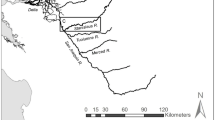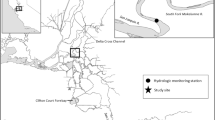Abstract
We evaluated the effects of non-native, piscivorous fish removal and artificial flow manipulation on survival and migration speed of juvenile Chinook salmon, Oncorhynchus tshawytscha, emigrating through the eastern Sacramento-San Joaquin Delta of California (Delta) using a Before-After-Control-Impact study design. Acoustically-tagged salmon survival increased significantly after the first predator reduction in the impact reach. However, survival estimates returned to pre-impact levels after the second predator removal. When an upstream control gate opened (increasing flow and decreasing tidal effect) juvenile salmon emigration time decreased and survival increased significantly through the impact reach. Though a short-term, single season experiment, our results demonstrate that predator control and habitat manipulation in the Delta tidal transition zone can be effective management strategies to enhance salmon survival in this highly altered system.






Similar content being viewed by others
References
Anderson J, Gurarie E, Zabel R (2005) Mean free-path length theory of predator–prey interactions: application to juvenile salmon migration. Ecol Model 186:196–211
Beamesderfer R, Ward D, Nigro A (1996) Evaluation of the biological basis for a predator control program on northern pikeminnow (Ptychocheilus oregonensis) in the Columbia and Snake rivers. Can J Fish Aquat Sci 53:2898–2908
Burnham K, Anderson D (2002) Model selection and multimodel inference: a practical information-theoretic approach. Springer, New York
Brandes P, McLain J (2001) Juvenile Chinook Salmon Abundance, Distribution, and Survival in the Sacramento-San Joaquin Estuary. Intranet, Series: California Department of Fish and Game Fish Bulletin, Vol. 179, Page(s): 39–136
Case T, Gilpin M (1974) Interference competition and niche theory. Proc Natl Acad Sci 71:3073–3077
CDFA [California Department of Food and Agriculture] (2006) California agricultural resource directory. California Department of Food and Agriculture, Sacramento
Cohen A, Carlton J (1998) Accelerating invasion rate in a highly invaded estuary. Science 279:555–558
EIFAC [European Inland Fisheries Advisory Commission] (1991) Report of the international seminar on mass removal of unwanted fish in large inland water bodies. Occasional paper No. 26. European Inland Fisheries Advisory Commission, Rome, Italy
Foerster R, Ricker W (1941) The effect of reduction of predaceous fish on survival of young sockeye salmon at Cultus Lake. J Fish Res Board Can 5:315–336
Fritts A, Pearsons T (2004) Smallmouth bass predation on hatchery and wild salmonids in the Yakima River, Washington. Trans Am Fish Soc 133:880–895
Goeman T, Spencer P (1992) Fish community responses to manipulation of northern pike and yellow perch densities in a Minnesota centrarchid lake. Minn Dep Nat Resour Sect Fish Invest Rep, No, 416
Hankin D, Dauble D, Pizzimenti J, Smith P (2010) The Vernails adaptive management program (VAMP): report of the 2010 review panel. http://www.sjrg.org/peerreview/review_vamp_panel_report_final_051110.pdf. Accessed 14 September 2011
Hubbs C (1940) Predator control in relation to fish management in Alaska. Trans N Am Wildl Nat Resour Conf 5:153–162
Jacobsen W (1945) The Bounty system and predator control. Calif Fish Game 31:53–63
Kimmerer W, Nobriga M (2008) Investigating particle transport and fate in the Sacramento-San Joaquin delta using a particle tracking model. San Francisco Estuary and Watershed Science 6(1) http://escholarship.org/uc/item/547917gn. Accessed 16 September 2011
Koonce J, Eshenroder R, Christie G (1993) An economic injury level approach to establishing the intensity of sea lamprey control in the Great Lakes. N Am J Fish Manage 13:1–14
Korman J, Yard M, Walters C, Coggins L (2009) Effects of fish size, habitat, flow, and density on capture probabilities of age-0 rainbow trout estimated from electrofishing at discrete sites in a large river. Trans Am Fish Soc 138:58–75
LaCroix G (2008) Influence of origin on migration and survival of Atlantic salmon (Salmo salar) in the Bay of Fundy, Canada. Can J Fish Aquat Sci 65:2063–2079
Lindley S, Mohr M (2003) Modeling the effect of striped bass on the population viability of Sacramento River winter-run Chinook salmon. Fishery Bulletin, 321–331
Lindley, S, Schick T, May B, Anderson J, Greene S, Hanson C, Low A, McEwan D, MacFarlane R, Swanson C, Williams J (2004) Population structure of threatened and endangered Chinook salmon ESUs in California's Central Valley Basin. U. S. Department of Commerce, NOAA Technical Memorandum NMFS-SWFSC-360
Maceina M, Wren B, Lower D (1995) Estimating harvestable largemouth bass abundance in a reservoir with an electrofishing catch depletion technique. N Am J Fish Manag 15:103–109
McLain J, Castillo G (2009) Nearshore areas used by fry Chinook salmon, Oncorhynchus tshawytscha, in the northwestern Sacramento-San Joaquin Delta, California. San Francisco Estuary and Watershed Science, 7(2). Accessed July 15 2011 http://www.escholarship.org/uc/item/4f4582tb
McMichael G et al (2010) The juvenile salmon acoustic telemetry system: a new tool. Fisheries 35:9–22
Meachum C, Clark J (1979) Management to increase anadromous salmon production. In: Clepper H (ed) Predator–prey systems in fisheries management. Sport Fishing Institute, Washington, pp 377–386
Meador M, Cuffney T, Gurtz M (1993) Methods for sampling fish communities as part of the National Water-Quality Assessment Program. U.S. Geological Survey. Raleigh, North Carolina. Open-File Report 93–104
Miller J, Gray A, Merz J (2010) Quantifying the contribution of juvenile migratory phenotypes in a population of Chinook salmon (Oncorhynchus tshawytscha). Mar Ecol Prog Ser 408:227–240
Moser M, Olson A, Quinn T (1990). Effects of dummy ultrasonictransmitters on juvenile coho salmon. In N. C. Parker et al. (editors), Fish-marking techniques, p. 353–356. Am. Fish. Soc. Symp. 7
Moyle P (2002) Inland fishes of California. University of California Press
Moyle P, Marchetti M (2006) Predicting invasion success: freshwater fishes in California as a model. Bioscience 56:515–524
Moyle PB, Lund JR, Bennett WA, Fleenor WE (2010) Habitat variability and complexity in the upper San Francisco Estuary. San Francisco Estuary and Watershed Science, 8(3). http://escholarship.org/uc/item/0kf0d32x. Accessed 15 September 2011
NMFS [National Marine Fisheries Service] (2009) Public draft Recovery Plan for the evolutionarily significant units (ESU) of Sacramento River winter-run Chinook salmon and spring-run Chinook salmon and the distinct population segment of Central Valley steelhead. October 2009
Nobriga M, Feyrer F (2007) Shallow-water piscivore-prey dynamics in California’s Sacramento-San Joaquin Delta. San Francisco Estuary and Watershed Science 5(2). http://escholarship.org/uc/item/387603c0. Accessed 15 September 2011
Otis K (1988) Effects of freshwater drum removal in Lake Winnebago, 1967–1981. Wis Dep Nat Resour Rep, No, 145
Perry R (2010) Survival and Migration Dynamics of Juvenile Chinook Salmon in the Sacramento-San Joaquin River Delta. Doctoral dissertation. University of Washington
Perry R, Brandes P, Sandstrom P, Ammann A, MacFarlane B, Klimley AP, Skalski JR (2010) Estimating survival and migration route probabilities of juvenile Chinook salmon in the Sacramento–San Joaquin River Delta. N Am J Fish Manag 30:142–156
Raleigh R, Short C (1981) Depletion sampling in stream ecosystems: assumptions and techniques. Progressive Fish-Culturist 43:115–120
Sall J, Lehman A, Creighton L (2001) JMP start statistics: a guide to statistics and data analysis. Duxbury, Pacific Grove
Sanderson B, Barnas K, Wargo Rub A (2009) Nonindigenous species of the Pacific Northwest: an overlooked risk to endangered salmon? Bioscience 59:245–256
Skalski JR, Lady J, Townsend R, Giorgi A, Stevenson J, Peven C, McDonald R (2001) Estimating in-river survival of migrating salmonid smolts using radiotelemetry. Can J Fish Aquat Sci 58:1987–1997
Smith B, Tibbles J (1980) Sea lamprey (Petromyzon manrimus) in lakes Huron, Michigan, and Superior: history of invasion and control, 1936–78. Can J Fish Aquat Sci 37:1780–1801
Sommer T, Nobriga M, Harrell W, Batham W, Kimmer W (2001) Floodplain rearing of juvenile Chinook salmon: evidence of enhanced growth and survival. Can J Fish Aquat Sci 58:325–333
Stewart-Oaten A, Murdoch W, Parker K (1986) Environmental impact assessment: pseudoreplication in time? Ecology 67:305–339
Stuehrenberg L, Giorgi A, Bartlett C (1990) Pulse-coded radio tags for fish identification. In N. C. Parker et al. (editors), Fish-marking techniques, p. 370–374. Am. Fish. Soc. Symp. 7.
White G, Burnham K (1999) Program MARK: survival estimation from populations of marked animals. Bird Study 46 Supplement: 120–138.
Zale A, Brooke C, Fraser W (2005) Effects of surgically implanted transmitter weights on growth and swimming stamina of small adult westslope cutthroat trout. Trans Am Fish Soc 134:653–660
Zimmerman M, Ward D (1999) Index of predation on juvenile salmonids by Northern Pikeminnow in the Lower Columbia River Basin, 1994–1996. Trans Am Fish Soc 128:995–1007
Acknowledgments
Financial support for this work was provided by the State and Federal Contractors Water Agency. We gratefully acknowledge the East Bay Municipal Utility District Fisheries and Wildlife Office and all field staff that helped develop and collect data for this study, and the collaborative support of the California Department of Fish and Game staff of the Mokelumne River Fish Hatchery. N. Christensen and P. Kuechle offered valuable input on data filtering. K. Jones and C. Watry provided significant project management and data analysis support. R. Sitts, P. Brandes, L. Fryer, and two anonymous reviewers provided constructive comments on the manuscript.
Author information
Authors and Affiliations
Corresponding author
Rights and permissions
About this article
Cite this article
Cavallo, B., Merz, J. & Setka, J. Effects of predator and flow manipulation on Chinook salmon (Oncorhynchus tshawytscha) survival in an imperiled estuary. Environ Biol Fish 96, 393–403 (2013). https://doi.org/10.1007/s10641-012-9993-5
Received:
Accepted:
Published:
Issue Date:
DOI: https://doi.org/10.1007/s10641-012-9993-5




